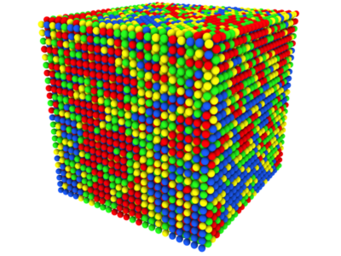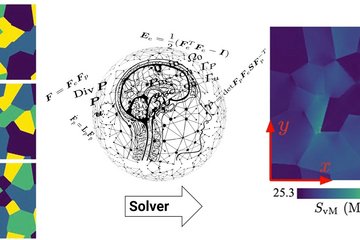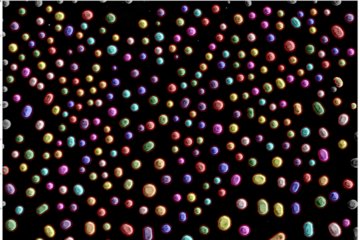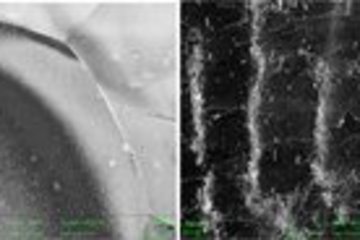Phase Stability and Short-Range Order of High Entropy Alloys
A high degree of configurational entropy is a key underlying assumption of many high entropy alloys (HEAs). However, for the vast majority of HEAs very little is known about the degree of short-range chemical order as well as potential decomposition. Recent studies for some prototypical face-centered cubic (fcc) HEAs such as CrCoNi showed that short-range order (SRO) can influence critical materials properties as, e.g., stacking fault energies. For refractory HEAs, due to slow diffusivity chemical ordering may hardly ever be achieved under typical experimental conditions but could potentially influence creep properties long-term applications. In this project we therefore study the phase stability and short-range order of selected fcc as well as bcc refractory HEAs computationally.
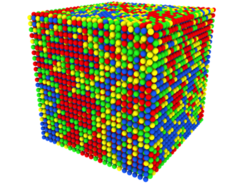
For this purpose, we resort to a set employ two complementary first-principles strategies. The first one is based on the generalized perturbation method (GPM) in combination with the coherent potential approximation (CPA) [1,2]. Based on this effective pair interactions are computed on the ideal lattice i.e. without taking local lattice distortions into account. Based on subsequent Monte Carlo calculations the phase decomposition as well as short-range order parameters are calculated. Application to bcc NbMoTaW revealed a long-ranged nature of these interactions. An advantage of this approach is further that magnetic fluctuations can be taken into account straightforwardly which is beneficially when studying magnetic alloys such as fcc VCoNi [2].
More recently novel machine-learning methods, such as the low-rank potential (LRP) [2-4] method, have been utilized which allow in combination with explicit supercell calculations to account also for explicit relaxations in a similar spirit as cluster expansion techniques, being, however, computationally more efficient. Application to the same bcc NbMoTaW HEA revealed that while the impact on local relaxations on short-range order parameters is not crucial, it is significant in revealing the decomposition and phase stability at moderate temperatures, where also a new intermediate relaxation-stabilized layered-structure has been found [4].
There has been also recent interest in exploring the possibility of so-called refractory high-entropy superalloys (RSAs). These are also multicomponent refractory alloys featuring, however, dual-phase microstructures with disordered bcc A2 and ordered B2 phases, which could result in improved mechanical properties. Al is usually added to form a B2 phase in such bcc refractory alloys (beneficial for reducing the alloy density, improving oxidation resistance, etc.). Though B2 phase formation in Al-containing bcc multicomponent refractory alloys is still somewhat intriguing, since B2 phases in many Al binaries with refractory elements are typically not observed. In this project we therefore explore chemical ordering in a number of refractory HEAs. Employing the LRP method to a prototypical bcc AlNbTiV HEA revealed indeed B2 ordering below about 1700 K, mainly caused by a strong site preference of Al and Ti [5]. In the courtesy of this project SRO as well as phase stability for a number of protoypical bcc as well as fcc HEAs will be investigated in collaboration with out experimental partners.
Further reading
Other related projects on HEAs are, e.g., on interstitial alloying.
Acknowledgments
This work is supported by the Deutsche Forschungsgemeinschaft (DFG, German Research Foundation) within the special priority programme “Compositionally Complex Alloys – High Entropy Alloys (CCA-HEA)” (SPP 2006) and via Project number 429582718.
References
[1] Körmann, F., Ruban, A. V. & Sluiter, M. H. Long-ranged interactions in bcc NbMoTaW high-entropy alloys. Materials Research Letters 5, 35–40 (2017).
[2] T Kostiuchenko, AV Ruban, J Neugebauer, A Shapeev, F Körmann, Phys. Rev. Mat. 4, 113802 (2020).
[3] Shapeev, A. Accurate representation of formation energies of crystalline alloys with many components. Computational Materials Science 139, 26–30 (2017).
[4] T. Kostiuchenko, F. Körmann, J. Neugebauer, A. Shapeev, npj Comp. Mat. 5, 55 (2019).
[5] F. Körmann, T. Kostiuchenko, A. Shapeev, J. Neugebauer, Phys. Rev. Mat. 5, 053803 (2021).
